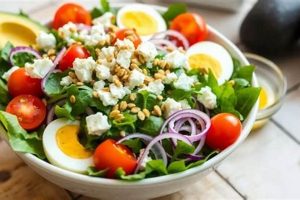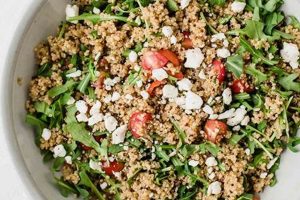Cooking lettuce and other salad components over direct heat enhances their flavor profile, adding a smoky char and altering their texture. This technique, often applied to sturdy greens like romaine, radicchio, or endive, can also be used for vegetables commonly found in salads, such as bell peppers, onions, zucchini, and corn. For instance, a simple preparation might involve halving romaine hearts, brushing them with olive oil, and grilling them until slightly wilted and marked by the grill. These are then often combined with other grilled elements and a flavorful dressing to create a complete dish.
Warm salads offer a compelling alternative to traditional raw preparations. The caramelization that occurs during grilling creates a depth of flavor not achievable with raw ingredients. This method also offers nutritional advantages, as grilling certain vegetables can increase the bioavailability of specific nutrients. Historically, grilling as a cooking method predates modern civilization, but its application to salads is a more recent culinary development, reflecting a growing interest in exploring diverse textures and flavors within the context of healthy eating.
The following sections will delve into specific recipes, exploring variations in grilling techniques, ingredient combinations, and complementary dressings to create a range of delicious and satisfying warm salads.
Tips for Grilling Salads
Achieving optimal results when grilling salad components requires attention to detail and an understanding of how different ingredients respond to heat. These tips offer guidance for creating flavorful and texturally appealing grilled salads.
Tip 1: Choose Sturdy Greens: Delicate greens like spinach or butter lettuce are unsuitable for grilling. Opt for robust varieties such as romaine, radicchio, or endive, which can withstand higher temperatures without wilting excessively.
Tip 2: Proper Preparation: Ensure vegetables are clean, dry, and appropriately sized for even cooking. Larger vegetables might require pre-cooking or slicing before grilling.
Tip 3: Oil and Seasoning: Lightly coat vegetables with oil to prevent sticking and promote caramelization. Seasoning can be applied before or after grilling, depending on the desired flavor profile.
Tip 4: Control Heat: A medium-high heat allows for proper charring without burning. Avoid excessively high heat, which can lead to uneven cooking and bitterness.
Tip 5: Grill in Batches: Overcrowding the grill prevents proper heat circulation and can result in steaming rather than grilling. Grill ingredients in batches to ensure optimal results.
Tip 6: Monitor Closely: Grilling times vary depending on the ingredient and desired doneness. Observe vegetables closely and remove them from the grill once they reach the desired texture and color.
Tip 7: Consider Marinades: Marinades add flavor and can help tenderize tougher vegetables. Use marinades sparingly to prevent excessive burning on the grill.
Tip 8: Balance Flavors: Combine grilled elements with complementary ingredients and dressings. Consider contrasting textures and temperatures to create a well-rounded and satisfying salad.
By following these guidelines, one can elevate simple salads into complex and flavorful dishes, showcasing the unique qualities of grilled ingredients.
The subsequent section will provide a collection of inspiring recipes to further explore the versatility of grilled salads.
1. Ingredient Selection
Ingredient selection significantly impacts the success of grilled salads. The inherent qualities of chosen componentstexture, flavor profile, and moisture contentdirectly influence the final dish. Robust greens like romaine, radicchio, and endive hold up well under heat, developing desirable char and retaining structural integrity. Conversely, delicate greens like spinach or butter lettuce wilt rapidly, rendering them unsuitable for grilling. Selecting vegetables with complementary flavors and varied textures creates a more complex and satisfying salad. For example, the sweetness of grilled corn can balance the slight bitterness of grilled radicchio, while the firm texture of grilled halloumi cheese contrasts with the tender leaves of grilled romaine.
Beyond greens and vegetables, other ingredients contribute to the overall composition of a grilled salad. Proteins such as grilled chicken, fish, or tofu add substance and nutritional value. Cheese, nuts, and seeds provide textural contrast and flavor complexity. Incorporating fruits like grilled peaches, pineapple, or watermelon introduces an element of sweetness and acidity, balancing the savory components. The choice of ingredients also determines the nutritional profile of the salad, offering opportunities to incorporate specific vitamins, minerals, and antioxidants. Grilling enhances the bioavailability of certain nutrients, further emphasizing the importance of thoughtful ingredient selection.
Strategic ingredient selection elevates grilled salads from simple side dishes to main courses. Balancing flavors, textures, and nutritional value ensures a satisfying and healthful culinary experience. Careful consideration of ingredient characteristicshow they respond to heat, their individual flavors, and their compatibility with other componentsis essential for crafting successful and delicious grilled salads. This understanding empowers culinary exploration and allows for seasonal adaptations, maximizing the versatility and enjoyment of this cooking technique.
2. Grilling Techniques
Grilling techniques significantly influence the outcome of grilled salad recipes. Direct grilling, where food is placed directly over the heat source, imparts intense char and smoky flavors, ideal for sturdy vegetables like bell peppers, onions, and zucchini. Indirect grilling, utilizing lower temperatures and placing food away from the direct flame, allows for more even cooking of denser items like sweet potatoes or whole heads of romaine lettuce. The technique impacts not only the flavor profile but also the texture of the ingredients. Direct grilling creates crisp exteriors and tender interiors, while indirect grilling yields a more uniformly cooked product, suitable for vegetables that require longer cooking times.
Mastery of specific techniques, such as creating grill marks and achieving the desired level of doneness, elevates grilled salads beyond simply cooked vegetables. Skillful application of direct grilling can create visually appealing grill marks, enhancing presentation. Understanding the relationship between cooking time and desired texture ensures vegetables retain optimal firmness without becoming mushy or overcooked. For example, quickly grilling romaine lettuce halves creates a slightly wilted texture with a smoky char, whereas grilling thick slices of eggplant requires lower heat and longer cooking times to achieve a creamy interior. Furthermore, the chosen technique influences the overall nutritional value. While high-heat grilling can potentially cause nutrient loss if vegetables are overcooked, proper application preserves vitamins and minerals, maximizing the health benefits.
Selecting appropriate grilling techniques depends on the specific ingredients and desired outcome. Utilizing a combination of direct and indirect grilling methods often yields the best results, allowing for both charring and thorough cooking. Attention to heat control, cooking time, and ingredient placement on the grill ensures consistent quality and flavor. Ultimately, understanding the nuances of various grilling techniques empowers one to create complex and flavorful grilled salads, maximizing the potential of this culinary approach.
3. Flavor Combinations
Flavor combinations play a pivotal role in the creation of compelling grilled salads. The interplay of sweet, savory, smoky, bitter, and acidic notes elevates these dishes beyond simple assemblages of grilled ingredients. Understanding how different flavor profiles interact and complement each other is crucial for crafting balanced and nuanced salads.
- Sweet and Smoky:
The natural sweetness of grilled fruits, such as peaches or pineapple, harmonizes beautifully with the smoky char imparted by the grilling process. This combination offers a delightful contrast, especially when paired with savory elements like grilled halloumi or prosciutto. The sweetness tempers the smokiness, preventing it from becoming overpowering, while the smokiness adds depth to the sweetness of the fruit.
- Bitter and Tangy:
Grilled radicchio or endive offer a pleasant bitterness that pairs well with tangy dressings containing citrus or vinegar. This combination provides a refreshing counterpoint to richer, more savory components. The tanginess cuts through the bitterness, creating a balanced and invigorating flavor profile. Examples include a grilled radicchio salad with orange vinaigrette or a grilled endive salad with lemon-herb dressing.
- Umami and Earthy:
Grilled portobello mushrooms provide a rich, earthy umami flavor that complements the nuttiness of grilled vegetables like zucchini or eggplant. This combination creates a savory depth, particularly when enhanced by ingredients like toasted nuts or crumbled cheese. A balsamic glaze or a red wine vinaigrette further amplifies the umami notes, resulting in a robust and satisfying salad.
- Spicy and Cooling:
Incorporating spicy elements, such as grilled jalapeos or a sriracha-infused dressing, adds a dynamic kick to grilled salads. Balancing the heat with cooling elements, such as cucumber, yogurt, or mint, creates a complex and refreshing flavor experience. This contrast stimulates the palate and adds another dimension to the overall composition of the salad.
These flavor combinations illustrate the potential for complexity and nuance within grilled salad recipes. Strategic pairing of contrasting yet complementary flavors elevates these dishes, transforming them from simple sides into sophisticated and satisfying culinary creations. Exploring different combinations allows for endless variations and personalized flavor profiles, showcasing the versatility of grilled salads.
4. Dressing Choices
Dressing choices profoundly influence the overall flavor profile and balance of grilled salads. While grilling imparts distinct smoky and charred notes to the ingredients, the dressing acts as a unifying element, harmonizing the diverse flavors and textures. The inherent richness and slight bitterness often present in grilled components necessitate careful dressing selection. An overly heavy or rich dressing can mask the nuanced flavors developed during grilling, while a bland dressing fails to complement the complexity of the charred ingredients. The interplay between the dressing and the grilled elements is crucial; the dressing should enhance, not overpower, the flavors of the grilled components. For example, a light and tangy vinaigrette, perhaps with lemon or herbs, effectively cuts through the richness of grilled halloumi and balances the smoky char of grilled romaine, while a creamy, ranch-style dressing may overwhelm the delicate flavors of grilled vegetables. Understanding this dynamic allows for strategic dressing choices tailored to specific grilled salad compositions.
Practical applications of this understanding involve considering the intensity of the grilled flavors and the overall desired balance. A salad featuring intensely smoky grilled eggplant might benefit from a bright, herbaceous dressing with lemon and parsley to provide a refreshing contrast. Conversely, a salad composed of lightly grilled vegetables, such as zucchini and bell peppers, might pair well with a nut-based dressing or a creamy vinaigrette infused with roasted garlic to complement the subtle char. The texture of the dressing also plays a role. A thin vinaigrette coats the ingredients lightly, allowing the grilled flavors to shine through, while a thicker, creamier dressing adds a textural dimension and can mellow the intensity of the char. These considerations demonstrate the practical significance of selecting appropriate dressings to elevate grilled salads.
Selecting the correct dressing is paramount for achieving a harmonious balance in grilled salads. It requires careful consideration of flavor profiles, textures, and the interplay between the dressing and the grilled ingredients. Successfully navigating these factors ensures that the dressing complements and enhances, rather than masks, the unique qualities imparted by the grilling process. Ultimately, thoughtful dressing choices elevate grilled salads from simple combinations of ingredients to well-composed and flavorful culinary experiences.
5. Nutritional Benefits
Grilled salad recipes offer significant nutritional advantages beyond traditional raw salads. The grilling process can enhance the bioavailability of certain nutrients while also offering a broader range of flavors and textures, encouraging consumption of a wider variety of vegetables. Understanding these nutritional benefits provides a deeper appreciation for the value of incorporating grilled salads into a healthy diet.
- Enhanced Bioavailability of Nutrients:
Grilling certain vegetables, such as tomatoes and carrots, can increase the bioavailability of key nutrients like lycopene and beta-carotene. Heat breaks down cell walls, making these nutrients more readily absorbed by the body. This enhanced absorption translates to greater nutritional value derived from consuming grilled vegetables compared to their raw counterparts. In grilled salads, this benefit is maximized by combining various grilled vegetables, contributing to a nutrient-rich meal.
- Retention of Vitamins and Minerals:
While some cooking methods can deplete vitamins and minerals, grilling, when done correctly, allows for retention of a significant portion of these essential nutrients. Proper grilling techniques, including avoiding overcooking and using minimal added fats, ensure that vegetables retain their nutritional integrity. This preservation of vitamins and minerals contributes to the overall health benefits of consuming grilled salads. For instance, grilling bell peppers retains their vitamin C content more effectively than boiling.
- Increased Antioxidant Intake:
Many vegetables commonly used in grilled salads, such as onions, peppers, and eggplant, are rich in antioxidants. The grilling process can concentrate these antioxidants, potentially increasing their beneficial effects. Antioxidants play a crucial role in protecting cells from damage caused by free radicals, contributing to long-term health. Including a variety of colorful grilled vegetables in salads maximizes antioxidant intake.
- Improved Digestive Health:
Grilling can make certain vegetables, such as cruciferous vegetables like broccoli and Brussels sprouts, easier to digest. The heat breaks down some of the fiber, reducing potential digestive discomfort while still providing valuable dietary fiber. This improved digestibility can encourage greater consumption of these nutrient-dense vegetables in grilled salad form.
Incorporating grilled salads into one’s dietary regimen offers a multifaceted approach to improving nutritional intake. By enhancing bioavailability, retaining essential vitamins and minerals, increasing antioxidant consumption, and improving digestibility, grilled salads provide a delicious and effective way to maximize the nutritional benefits derived from vegetables. The versatility of grilled salad recipes allows for customization based on individual dietary needs and preferences, further emphasizing their value in a balanced and healthy diet.
6. Seasonal Adaptations
Seasonal adaptations in grilled salad recipes maximize flavor and nutritional value while supporting local agriculture and sustainable practices. Aligning ingredient selection with seasonal availability ensures optimal ripeness and freshness, resulting in superior taste and higher nutrient density. This approach also reduces reliance on long-distance transportation and storage, minimizing environmental impact.
- Spring Salads:
Springtime offers an abundance of tender greens and young vegetables ideal for grilling. Asparagus, spring onions, and fresh peas bring vibrant flavors and textures to grilled salads. Combining these with light, citrus-based dressings creates a refreshing and nutritious meal. For example, grilled asparagus and pea salad with a lemon-herb vinaigrette embodies the essence of spring.
- Summer Salads:
Summer’s bounty provides a wide array of grilling options, from juicy tomatoes and sweet corn to zucchini and bell peppers. These vegetables develop rich, smoky flavors when grilled, and their vibrant colors add visual appeal to summer salads. Grilled corn and tomato salad with a balsamic glaze exemplifies the season’s richness.
- Autumn Salads:
Hearty autumn vegetables, such as root vegetables, Brussels sprouts, and winter squash, lend themselves well to grilling. Their robust flavors and textures offer a satisfying warmth during cooler months. Pairing grilled butternut squash and Brussels sprouts with a maple- Dijon vinaigrette creates a quintessential autumn salad.
- Winter Salads:
Even during winter, grilled salads can be enjoyed. Hearty greens like kale and radicchio hold up well on the grill, and winter citrus fruits offer a refreshing contrast to the charred flavors. A grilled kale salad with grapefruit and toasted walnuts provides a vibrant and nutritious option during the colder months.
Adapting grilled salad recipes to seasonal produce not only enhances flavor and nutritional value but also fosters a deeper connection to the natural rhythm of the year. This approach allows for continuous culinary exploration and ensures that each season’s unique offerings are celebrated in a healthful and delicious manner.
Frequently Asked Questions
This section addresses common inquiries regarding the preparation and enjoyment of salads featuring grilled components.
Question 1: Which types of lettuces are most suitable for grilling?
Heartier lettuce varieties, such as romaine, radicchio, and endive, withstand the heat of grilling without excessive wilting. Delicate greens, like spinach or butter lettuce, are less suitable.
Question 2: How can burning be prevented when grilling delicate vegetables?
Using medium-high heat, proper oiling, and close monitoring prevent burning. Pre-cooking denser vegetables before grilling also helps ensure even cooking.
Question 3: What are effective strategies for achieving optimal grill marks on vegetables?
Ensuring a clean grill grate, using adequately high heat, and avoiding overcrowding the grill surface promote distinct grill marks. Oiling the vegetables lightly also aids in achieving desirable sear marks.
Question 4: Can marinades be used with grilled salad ingredients?
Marinades enhance flavor but should be used judiciously to prevent burning. Oil-based marinades are generally preferred for grilling.
Question 5: How can one balance the smoky flavor imparted by grilling in a salad?
Balancing smoky flavors can be achieved through complementary ingredients and dressings. Fresh herbs, acidic components like citrus, and creamy cheeses or yogurts provide contrasting notes that harmonize with the smokiness.
Question 6: What are the key nutritional advantages of consuming grilled versus raw salads?
Grilling can enhance the bioavailability of certain nutrients in vegetables, such as lycopene in tomatoes. It also offers diverse flavors and textures, encouraging consumption of a wider range of vegetables.
Understanding these fundamental aspects contributes to the successful preparation and enjoyment of flavorful and nutritious grilled salads.
This concludes the FAQ section. The next section will offer a collection of sample recipes.
Grilled Salad Recipes
Exploration of grilled salad recipes reveals a dynamic interplay of flavor, texture, and nutritional value. Careful selection of hearty greens and vegetables, coupled with appropriate grilling techniques, forms the foundation for successful preparations. Strategic flavor combinations, balancing contrasting yet complementary notes, elevate these salads beyond simple grilled vegetables. Thoughtful dressing choices further enhance the final composition, harmonizing the diverse elements. The nutritional benefits of grilling, including enhanced bioavailability of certain nutrients, add another layer of value to these culinary creations. Adapting recipes to seasonal produce maximizes freshness, flavor, and sustainability.
Grilled salad recipes offer a versatile and adaptable approach to healthy eating, encouraging culinary creativity and a deeper appreciation for the inherent qualities of fresh ingredients. Continued exploration of grilling techniques and flavor combinations promises further innovation within this culinary realm, enriching dining experiences and promoting healthful eating practices.






